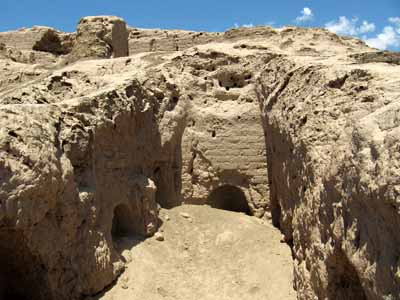Zoroastrianism, founded in Persia in perhaps the 6th century BC by the mysterious character known as Zoroaster, a.k.a Zarathustra of “Thus Spoke Zarathustra ” fame, is probably the world’s oldest “revealed” religion, and as such Zoroastrians are even regarded as “People of the Book”, along with Christians and Jews, by at least some Muslims (sorry, Buddhists remain garden-variety Idolators). The major premise of Zoroastrianism, as you no doubt know, is the vast cosmic struggle between Ahura Mazdah, the God of Light (very roughly speaking), and Ahriman, the principal of Darkness and Evil. Zoroastrianism was very widespread in the Transoxiania and Khorezm regions before the arrival of the Islam in the eight and ninth centuries. For an utterly titillating account of Zoroastrianism see In Search of Zarathustra
” fame, is probably the world’s oldest “revealed” religion, and as such Zoroastrians are even regarded as “People of the Book”, along with Christians and Jews, by at least some Muslims (sorry, Buddhists remain garden-variety Idolators). The major premise of Zoroastrianism, as you no doubt know, is the vast cosmic struggle between Ahura Mazdah, the God of Light (very roughly speaking), and Ahriman, the principal of Darkness and Evil. Zoroastrianism was very widespread in the Transoxiania and Khorezm regions before the arrival of the Islam in the eight and ninth centuries. For an utterly titillating account of Zoroastrianism see In Search of Zarathustra . For still more see Magi
. For still more see Magi .
.
Zoroastrian Burial Practices are of special interest. Bodies were placed on high hills or man-made summits and exposed to scavengers who soon stripped the bones clean. The bones were then preserved in containers known as ossuaries. A high place where the bodies were laid out was known as a Tower of Silence. One such Tower of Silence is located on the right bank of the Amu Darya River northeast of Khiva. After my stay in Khiva I wandered by this Tower of Silence.
Tower of Silence on the north bank of the Amu Darya
This particular Tower of Silence a man-made structure on top of a natural hill
Closer view of the man-made platform at the top of the hill
The south side of the platform
View south from the entranceway
The flat top of the burial platform with the Amu Darya in the distance
Another view of the flat top of the platform. Bodies were left here to be stripped down to the bones by vultures.
Irrigated lands next to the Amu Darya
Another view of irrigated lands next to the Amu Darya
The Amu Darya from the top of the Tower of Silence
































